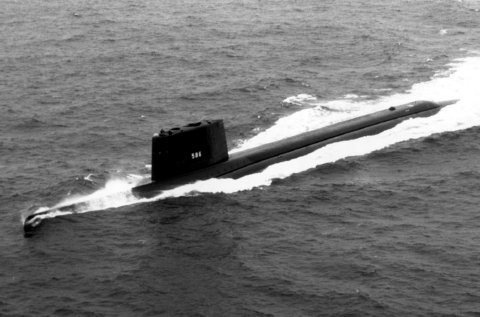 |
||||||||||||||||||||||||||||||||||||||||||||||||||||
 |
||||||||||||||||||||||||||||||||||||||||||||||||||||
| For RATING SHIRTS - Click on your Rating Abbreviation below: | ||||||||||||||||||||||||||||||||||||||||||||||||||||
|
||||||||||||||||||||||||||||||||||||||||||||||||||||
| Click on your Rating abbreviation above: | ||||||||||||||||||||||||||||||||||||||||||||||||||||


U.S.S. TRITON
(SSN-586)NULLI SECUNDUS
Click to view crew list
USS TRITON (SSN-586) - a Skipjack-class submarine
In Commission 1959 to 1969SSN-586 Deployments - Major Events
| Add a SSN-586 Shellback Initiation | Add a SSN-586 Deployment - Major Event | ||||
| Month | Year | to | Month | Year | Deployment / Event |
|---|---|---|---|---|---|
| MAY | 1956 | - | Keel Date: 29 MAY 1956 at General Dynamics Electric Boat Groton CT | ||
| AUG | 1958 | - | Launch Date: 19 AUG 1958 | ||
| NOV | 1959 | - | Commissioned: 10 NOV 1959 | ||
| FEB | 1960 | - | MAY | 1960 | Submerged Circumnavigation |
| SEP | 1960 | - | DEC | 1960 | Antarctic Circle |
| SEP | 1960 | - | DEC | 1960 | Blue Nose - Arctic Circle |
| JUN | 1961 | - | NOV | 1961 | Blue Nose - Arctic Circle |
| JUN | 1961 | - | NOV | 1961 | Blue Nose - Arctic Circle |
| JUL | 1964 | - | AUG | 1964 | Blue Nose - Arctic Circle |
| JAN | 1966 | - | MAR | 1966 | Blue Nose - Arctic Circle |
| MAY | 1969 | - | Decommissioned: 3 MAY 1969 | ||
SSN-586 General Specifications
Named for: Triton
Displacement: 5963 tons
Length: 447 feet 6 inches
Beam: 37 feet 0 inches
Draft: 23 feet 6 in
Final Disposition: Recycled
USS TRITON (SSN-586)
The fifth Triton (SSR(N)-586) was laid down on 29 May 1956 at Groton, Conn., by the Electric Boat
Division of the General Dynamics Corp.; launched on 19 August 1958; sponsored by Mrs. John Will; and
commissioned on 10 November 1959, Capt. Edward L. Beach in command.
Triton put to sea on her shakedown cruise on 15 February 1960, bound for the South Atlantic. She arrived
in the middle Atlantic off St. Peter and St. Paul Rocks on 24 February to commence a history-making voyage. Having
remained submerged since her departure from
the east coast, Triton continued on south towards Cape Horn, rounded the tip of South America, and headed west across the Pacific. After
transiting the Philippine and
Indonesian archipelagoes and crossing
the Indian Ocean, she rounded the Cape of Good Hope and arrived off the St. Peter and Paul Rocks on 10 April-60
days and 21 hours after departing the mid-ocean
landmark. Only once did her sail break the surface of the sea, when she transferred a sick sailor to Macon (CA-132) off Montevideo, Uruguay,
on 6 March. She arrived back at
Groton on 10 May, having completed the first submerged circumnavigation of the earth.
Triton's globe-girdling cruise proved invaluable to the
United States. Politically, it enhanced the nation's prestige. From an
operational viewpoint, the cruise demonstrated
the great submerged endurance and sustained high-speed transit
capabilities of the first generation of
nuclear-powered submarines. Moreover, during
the voyage, the submarine collected reams of oceanographic data. At the cruise's conclusion, Triton received the Presidential Unit Citation and
Captain Beach received the Legion of
Merit from President Dwight D. Eisenhower.
Following her
post-shakedown availability, Triton assumed her duties as a radar picket submarine in August 1960. She was then deployed to northern European waters with
the 2d Fleet to participate in NATO exercises oriented around detecting and intercepting Soviet bombers overflying the arctic. She finished the deployment with a port visit to Bremerhaven, West Germany.
For the first half of
1961, Triton conducted operational patrols and training exercises
with the Atlantic Fleet. During this period,
the rising threat posed by Russian
submarine forces increased the Navy's demands for nuclear-powered attack submarines with antisubmarine warfare
(ASW) capability. Accordingly, upon the demise of the Navy's radar picket submarine program following the completion of the land-based Distant Early Warning (DEW) radar stations in Canada, Triton was
redesignated SSN-586 on 1 March 1961
and entered the Portsmouth (N.H.) Naval Shipyard in June 1962 for conversion to an attack submarine.
In March 1964, upon completion of this overhaul, Triton's home port was changed from New London, Conn., to Norfolk, Va. On 13 April 1964, Triton became the flagship for the Submarine Force, Atlantic
Fleet, and served in that role until
relieved by Ray (SSN-653) on 1
June 1967. Eleven days later, Triton was shifted to her original
home port of New London.
Because of cutbacks in defense spending, as well as the expense of operating her twin nuclear reactors, Triton's scheduled
1967 overhaul was cancelled indefinitely, and the submarine-along with 50 other vessels-was scheduled for
inactivation. From October 1968 through May of
1969, the submarine underwent preservation and inactivation processes and was decommissioned on 3 May 1969, the first nuclear-powered submarine to do so. On the 6th,
Triton departed New London under
tow and proceeded to Norfolk where she was placed in the inactive fleet. Although stricken on 30 April 1986, she remained berthed at Norfolk until 1995 when she was towed to Bremerton, Wash., for disposal. The submarine moved into drydock at the Puget Sound Naval Shipyard in mid-2007 to commence scrapping under the Submarine Recycling Program.
Triton (SSN-586) in dry dock at the Puget Sound Naval Shipyard circa November 2007. (Photo courtesy of PSNY, Bremerton, Wash.)
Triton received both a Presidential Unit Citation and a Navy Unit Commendation during her service with the fleet.
Photograph and disposition update, January 2008
[Note: The above USS TRITON (SSN-586) history may, or may not, contain text provided by crew members of the USS TRITON (SSN-586), or by other non-crew members, and text from the Dictionary of American Naval Fighting Ships]